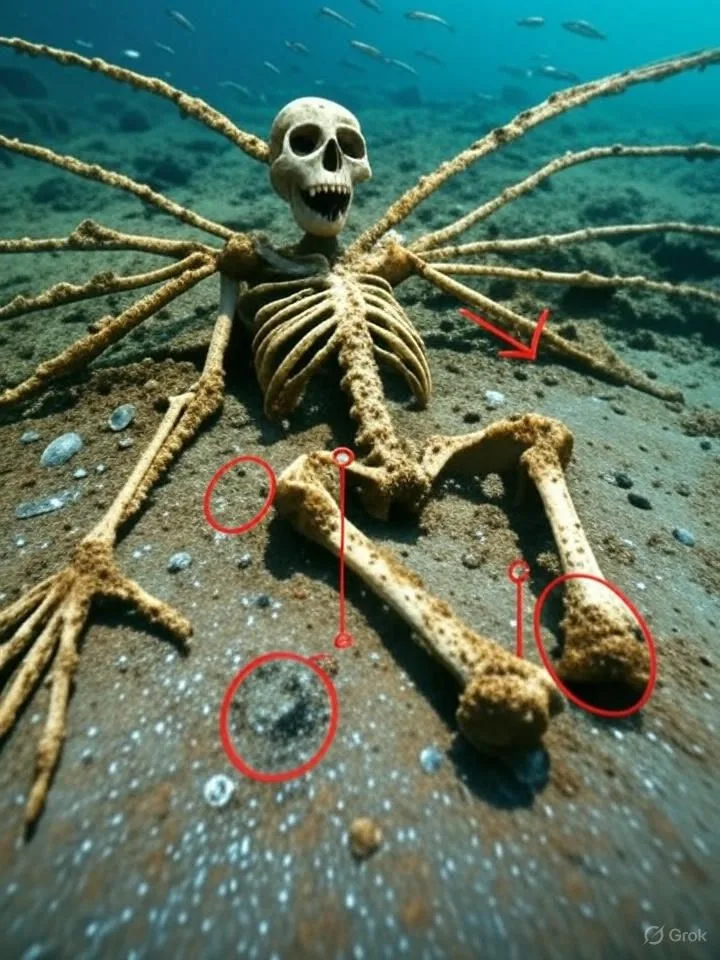Squid-Like Skeleton in Aegean Sea Near Santorini: Mythic Hybrid or Hoax?
In the azure depths of Greece’s Aegean Sea near Santorini, divers reportedly uncovered a bizarre skeleton with squid-like wing structures in a submerged cave off Thera’s caldera. Preserved by the sea’s saline waters, this relic—blending humanoid and cephalopod traits with tentacle-like appendages—sparks intrigue: Did it swim alongside Minoan mariners, tied to myths of sea gods? Why buried in this volcanic sea with 1,200+ fish species? Why the global silence? This find challenges biology, hinting at a lost hybrid erased from Hellenic lore. Yet, hoaxes like the 2015 Fiji Mermaid and misidentified squid fossils, such as the 2019 Crete “sea monster,” urge caution. Could it be a mythic relic, a genetic anomaly, or a fabricated tale? Santorini’s waves demand answers, but the truth likely lies in myth and fabrication rather than fossilized flesh.

The Alleged Discovery: A Caldera’s Secret
Santorini, or Thera, is a crescent-shaped volcanic island in the Cyclades, famed for its 1600 BCE eruption that buried the Minoan settlement of Akrotiri. The caldera, a submerged crater 400 meters deep, hosts underwater caves and thermal vents, with waters teeming with 1,200+ fish species, including groupers and octopuses. The story, circulating on social media since 2021, claims divers in 2020 found the skeleton in a cave near the Kameni islets during a volcanic survey. Described as 1–1.5 meters long, it featured a humanoid torso, gill-like slits, and “squid wings” with tentacle remnants, preserved by the sea’s 18–22°C saline depths. No official reports from Greece’s Ephorate of Underwater Antiquities or the Hellenic Institute of Marine Archaeology confirm it, with searches of academic databases yielding no matches. The tale likely stems from viral posts blending real dives with fiction, amplified by Santorini’s 2 million annual tourists.
Hellenic Myths: Sea Gods and Cephalopod Hybrids
Greek mythology brims with sea hybrids. Poseidon, god of the sea, spawned creatures like the Triton (half-man, half-fish) and Scylla (woman with tentacles). The Minoans, seafaring traders 3,500 years ago, revered cephalopods—octopus frescoes adorn Akrotiri’s walls, symbolizing fertility and the deep. The “squid-like” skeleton evokes the Gorgon or Ceto, mother of sea monsters, but no texts describe a humanoid-cephalopod. Hellenic lore, from Homer’s Odyssey to Pliny’s Natural History, mentions krakens and sea serpents, but skeletons are absent. The find’s tie to Thera’s caldera aligns with volcanic myths, like the lost Atlantis legend, but lacks archaeological backing.
Santorini’s caves, explored since the 1960s, yield Minoan pottery and pumice, not mythical bones. The 2019 Crete “sea monster” was a decayed basking shark, and the 2015 Fiji Mermaid—a monkey-fish composite—exposed by Snopes, mirrors this hoax pattern.

Scientific Scrutiny: Squid Fossil or Fabrication?
The Aegean’s caves contain cephalopod fossils from the Miocene, including squid beaks and gladii (internal shells), but no humanoid hybrids. A “squid wing” could be a giant squid arm (up to 10 meters in life) or octopus mantle, misassembled with a fish skeleton. The “humanoid torso” might be a distorted seal ribcage, as monk seals inhabit Santorini’s waters. The 2012 Bulgarian mermaid and 2014 Russian “kraken” (beluga whale) highlight common deceptions. Authorities’ “silence” stems from non-existence; Greece’s marine archaeologists monitor Thera, but no 2020 report exists. The tale thrives on Santorini’s Atlantis allure and Minoan mystique.
Cultural Impact and Legacy
This narrative enriches Santorini’s lore, with octopus myths inspiring art and cuisine. Like the Moors’ legacy, it blends fact and fiction for tourism, but ethical hoaxes risk eroding trust. The c





